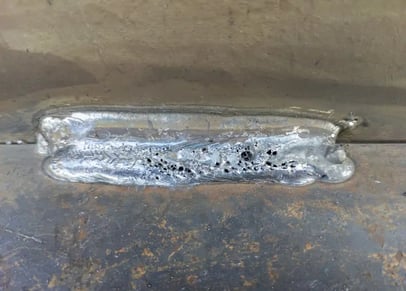Recognizing Porosity in Welding: Exploring Reasons, Results, and Prevention Strategies
As specialists in the welding industry are well conscious, comprehending the causes, effects, and avoidance techniques associated to porosity is essential for attaining durable and reputable welds. By delving right into the origin triggers of porosity, examining its destructive results on weld quality, and exploring efficient prevention methods, welders can improve their knowledge and skills to produce top notch welds consistently.
Typical Causes of Porosity
Porosity in welding is largely created by a combination of elements such as contamination, inappropriate shielding, and poor gas protection during the welding process. Contamination, in the kind of dust, oil, or rust on the welding surface area, develops gas pockets when warmed, causing porosity in the weld. Inappropriate protecting takes place when the securing gas, frequently utilized in procedures like MIG and TIG welding, is not able to completely safeguard the molten weld pool from reacting with the bordering air, causing gas entrapment and succeeding porosity. Furthermore, insufficient gas coverage, often as a result of inaccurate circulation rates or nozzle positioning, can leave components of the weld unguarded, permitting porosity to create. These variables collectively add to the formation of voids within the weld, damaging its stability and possibly creating architectural issues. Recognizing and addressing these common causes are essential action in preventing porosity and making sure the quality and toughness of welded joints.
Results on Weld Quality
The existence of porosity in a weld can significantly compromise the overall top quality and honesty of the welded joint. Porosity within a weld creates gaps or tooth cavities that compromise the framework, making it a lot more vulnerable to breaking, deterioration, and mechanical failure. These voids act as stress concentrators, reducing the load-bearing ability of the weld and boosting the possibility of early failure under used stress. On top of that, porosity can likewise serve as prospective sites for hydrogen entrapment, additional worsening the destruction of the weld's mechanical properties.
In addition, porosity can hinder the effectiveness of non-destructive testing (NDT) techniques, making it challenging to detect various other issues or discontinuities within the weld. This can bring about significant safety concerns, especially in essential applications where the architectural stability of the welded parts is vital.

Prevention Techniques Overview
Offered the destructive effect of porosity on weld high quality, effective prevention techniques are critical to preserving the structural honesty of bonded joints. One of the key prevention techniques is detailed cleaning of the base materials prior to welding. Pollutants such as oil, oil, corrosion, and moisture can add to porosity, so making sure a clean job surface is crucial. Appropriate storage of welding consumables in dry problems is likewise essential to avoid dampness absorption, which can result in gas entrapment throughout welding. Furthermore, selecting the proper welding parameters, such as voltage, present, and travel rate, can Get More Info assist decrease the danger of porosity development. Making sure adequate shielding gas flow and insurance coverage is one more critical avoidance strategy, as inadequate gas coverage can cause atmospheric contamination and porosity. Correct welder training and certification are vital for executing preventive actions efficiently and constantly. By including these avoidance strategies into welding techniques, the incident of porosity can be considerably decreased, causing stronger and extra trustworthy welded joints.
Importance of Correct Protecting
Appropriate protecting in welding plays a vital role in preventing atmospheric contamination and making certain the integrity of welded joints. Securing gases, such as argon, helium, or a mixture of both, are generally made use of to safeguard the weld swimming pool from responding with elements airborne like oxygen and nitrogen. When these reactive components article source enter contact with the hot weld swimming pool, they can cause porosity, resulting in weak welds with reduced mechanical properties.

Inadequate shielding can lead to numerous issues like porosity, spatter, and oxidation, compromising the structural stability of the bonded joint. Sticking to appropriate protecting methods is necessary to create top quality welds with minimal defects and guarantee the long life and integrity of the bonded elements.
Tracking and Control Approaches
Just Homepage how can welders successfully keep an eye on and manage the welding process to ensure optimal results and stop issues like porosity? One trick method is through making use of innovative monitoring technologies. These can consist of real-time tracking systems that offer responses on criteria such as voltage, existing, take a trip speed, and gas flow prices. By constantly checking these variables, welders can recognize inconsistencies from the suitable conditions and make immediate changes to stop porosity formation.

In addition, implementing appropriate training programs for welders is necessary for keeping track of and controlling the welding process effectively. What is Porosity. Enlightening welders on the importance of keeping constant specifications, such as proper gas securing and travel speed, can aid stop porosity problems. Regular evaluations and qualifications can likewise ensure that welders excel in surveillance and regulating welding processes
Furthermore, the usage of automated welding systems can improve monitoring and control capacities. These systems can exactly regulate welding criteria, decreasing the likelihood of human mistake and guaranteeing consistent weld top quality. By combining innovative tracking technologies, training programs, and automated systems, welders can properly keep an eye on and control the welding procedure to decrease porosity defects and attain top quality welds.
Verdict
